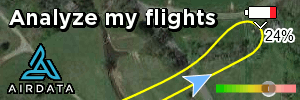Usually my P4 flies in waypoints mode and usually my flights have a duration "in the air" of about 15 minutes, so adding a few minutes for takeoff and landing I can complete the whole mission with about 30% of remaining battery.
But... it often happens to arrive on the spot and find some moderate wind, with or without gusts, and not knowing whether to take off or not for fear of battery life.
Are there any precise decision making parameters, not based on pilot's sensations ?
But... it often happens to arrive on the spot and find some moderate wind, with or without gusts, and not knowing whether to take off or not for fear of battery life.
Are there any precise decision making parameters, not based on pilot's sensations ?





